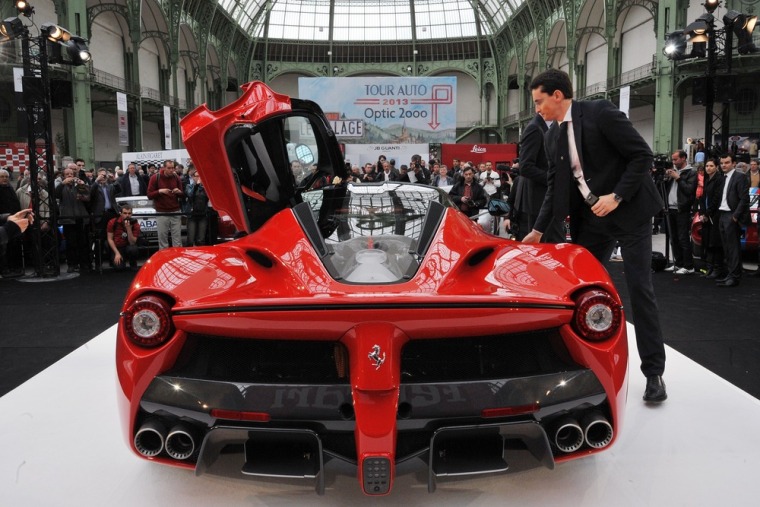At 455 horsepower, the 2014 Chevrolet Corvette Stingray is not only set to out-perform the maker’s original expectations but to deliver more muscle than any “base” ‘Vette since the two-seat sports car was first introduced 60 years ago.
That news came the same day that Aston Martin unveiled its fastest model ever, the 200 mph V12 Vantage S. In fact, for those who like performance, there are plenty of options – like the nearly 1,000 horsepower LaFerrari that will get you from 0 to 60 in fewer than 3 seconds.
While the media spotlight may be on green machines – from the $20,000 Chevrolet Spark EV to Tesla’s Model S, topping out at over $100,000 – muscle still matters to those paying.
Plug-based vehicles are expected to account for just 0.5 percent of the overall U.S. new vehicle market this year, a figure matched by the combined sales of three classic Detroit muscle cars, the Chevrolet Camaro, Ford Mustang and Dodge Challenger.
There’s no question the market is shifting to smaller, more fuel-efficient vehicles. Given the need to save fuel while not sacrificing size and comfort, many motorists are trimming their powertrain choices. A sizable number of midsize sedans like the Hyundai Sonata, for example, no longer offer V-6 options.
As recently as 2008, 26 percent of all new vehicles sold in the U.S. were equipped with V-8s, especially full-size trucks like the Ford F-Series, and performance cars such as the Camaro and the Mercedes-Benz SL63 AMG. Last year, however, that plunged to 19.9 percent, according to consulting firm AutoPacific Inc., which anticipates the number will continue declining.
That doesn’t mean performance will vanish with the V-8 (or even more muscular V-10s and V-12s). AutoPacific chief analyst George Peterson doesn’t expect to see the V-8 disappear entirely. It will maintain a strong presence in large trucks and in performance vehicles – like the Corvette. But today’s latest “eight-banger” is likely to be a very different machine from the powertrains found in the classic muscle and performance cars of yore.
Take the all-new LT1 engine found in the seventh-generation Corvette, known to fans as the C7. It adopts a variety of new features that achieve what was once thought impossible: Better performance while improving fuel economy.
That includes direct injection, in which fuel is sprayed directly into the cylinder to burn faster and more efficiently. Then there’s displacement on demand, where some of the engine’s cylinders are shut off while coasting or cruising, further reducing fuel consumption. Add in a more advanced transmission with more gears to ensure the engine is running at just the right speed—either to boost miles per hour or miles per gallon.
These features ensure that the new 2014 Chevrolet Corvette will yield 26 miles per gallon on the highway – the sort of number a Chevy Malibu owner might have bragged about several years ago.
Although final figures haven’t been released yet, the new Porsche 918 is expected to yield better economy – even though its 884-horsepower drivetrain will be able to launch it from 0 to 60 in a mere 2.8 seconds, with a top speed well into triple digits.
The supercar relies on a hybrid drivetrain integrating a 608-horsepower V-8 with two electric motors, one on each axle. When a driver isn’t looking for maximum performance, they’ll be able to get an estimated 18 miles in electric-only mode from the 918’s lithium-ion battery pack.
The new LaFerrari and the McLaren P1 supercar – both unveiled at the Geneva Motor Show in March – use a slightly less complex hybrid drive system, dubbed KERS, derived from the Formula One race series, to deliver maximum performance while also bumping up fuel economy during more sedate driving conditions.
Acura will take the high-tech route when it revives the NSX sports car next year. The two-seater will pair a V-6 engine with three separate electric motors, two of which will drive the front wheels. By ever-so-slightly altering the speed of each front motor, the NSX will be able to torque vector, using variations in power for each front wheel to enhance cornering.
Not all new muscle cars are becoming more eco-friendly. But general improvements in engine and transmission designs not only improve performance but boost fuel economy so that the latest Mustang V-6 model has topped the 300-hp barrier – delivering more muscle than the V-8 Mustang GT – while also achieving more than 30 mpg.
